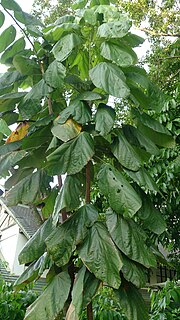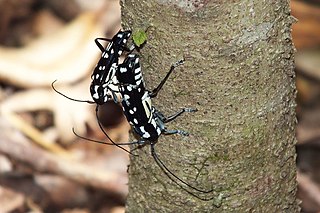Related Research Articles

Sorghum is a genus of about 25 species of flowering plants in the grass family (Poaceae). Some of these species are grown as cereals for human consumption and some in pastures for animals. One species, Sorghum bicolor, was originally domesticated in Africa and has since spread throughout the globe. Seventeen of the 25 species are native to Australia, with the range of some extending to Africa, Asia, Mesoamerica, and certain islands in the Indian and Pacific Oceans. One species is grown for grain, while many others are used as fodder plants, either cultivated in warm climates worldwide or naturalized in pasture lands. Sorghum is in the subfamily Panicoideae and the tribe Andropogoneae.

A bicolor cat or piebald cat is a cat with white fur combined with fur of some other color, for example black or tabby. There are various patterns of bicolor cat. These range from Turkish Van pattern through to solid color with a throat locket.

Quercus bicolor, the swamp white oak, is a North American species of medium-sized trees in the beech family. It is a common element of America's north central and northeastern mixed forests. It can survive in a variety of habitats. It forms hybrids with bur oak where they occur together in the wild.

Glenealy is one of the few roads or streets without a suffix in Hong Kong. Located in the Mid-Levels on the Hong Kong Island, Hong Kong, it starts from Ice House Street and goes uphill to Hong Kong Zoological and Botanical Gardens, across Robinson Road and ends at Hornsey Road and Conduit Road.

Sorghum bicolor, commonly called sorghum and also known as great millet, durra, jowari / jowar, or milo, is a grass species cultivated for its grain, which is used for food for humans, animal feed, and ethanol production. Sorghum originated in Africa, and is now cultivated widely in tropical and subtropical regions. Sorghum is the world's fifth-most important cereal crop after rice, wheat, maize, and barley, with 59.34 million metric tons of annual global production in 2018. S. bicolor is typically an annual, but some cultivars are perennial. It grows in clumps that may reach over 4 m high. The grain is small, ranging from 2 to 4 mm in diameter. Sweet sorghums are sorghum cultivars that are primarily grown for forage, syrup production, and ethanol; they are taller than those grown for grain.

The R752 road is a regional road in County Wicklow, Ireland. From its junction with the R772 in Rathnew on the outskirts of Wicklow Town it takes a generally south-westerly route to its junction with the R747 in the village of Woodenbridge, where it terminates.

Glenealy is a village 8 km (5.0 mi) west of Wicklow Town, in County Wicklow, on the R752. The Dublin - Rosslare railway line also passes through the village.
Glenealy can mean:

The bicolored roundleaf bat is a species of bat in the family Hipposideridae found in Indonesia, Malaysia, the Philippines, Thailand, and Timor-Leste. This bat inhabits caves, rock crevices and tunnels among lowland forests. They roost in large numbers and consumer mostly small winged insects. Their navigation and hunting skills come from the use of echolocation. Its leafnose is used to release ultrasonic shouts to distinguish its surroundings. Echolocation is also used to distinguish other species based on their wingbeat and size. The habitat of this bat decides the color of its fur. Bleaching fumes of a cave environment will cause an orange colored fur. Those who inhabit a well-ventilated roost will be a light brown color.
The 2005–06 All-Ireland Senior Club Hurling Championship was the 36th staging of the All-Ireland Senior Club Hurling Championship, the Gaelic Athletic Association's premier inter-county club hurling tournament. The championship began on 30 October 2005 and ended on 17 March 2006.

Glenealy Hurling Club is a Gaelic Athletic Association club located in the parish of Glenealy and Ashford in County Wicklow, Ireland. The club was founded in 1885 as a football club but switched codes to the game of hurling in the early 1920s.

Theobroma bicolor, known commonly as the mocambo tree, jaguar tree, balamte, or pataxte, among various other common names, is a tree in the genus Theobroma, which also contains the better-known Theobroma cacao. It is found in Central and South America, including stretches of the Amazon rainforest in Brazil, Colombia, Ecuador, and Peru.

Glenea is a genus of longhorn beetles belonging to the family Cerambycidae, subfamily Lamiinae.

Glenea venus is a species of beetle in the family Cerambycidae. It was described by James Thomson in 1865. It is known from Papua New Guinea, Australia and Indonesia.
Glenea chlorospila is a species of beetle in the family Cerambycidae. It was described by Charles Joseph Gahan in 1897. It is known from Taiwan and Japan.
Glenea lineata is a species of beetle in the family Cerambycidae. It was described by Charles Joseph Gahan in 1897.
Glenea glaucescens is a species of beetle in the family Cerambycidae. It was described by Per Olof Christopher Aurivillius in 1903 and is known from Sulawesi.
Glenea jordani is a species of beetle in the family Cerambycidae. It was described by Lepesme and Stephan von Breuning in 1952.

A Kambo cleansing, also known as a Kambo circle or Kambo ceremony, Kambo, vacina-do-sapo, or sapo, is a purge using skin secretions of the kambô, a species of frog. The effects on humans usually include nausea, vomiting, and diarrhea; use of kambo has caused several deaths. Kambo, which originated as a folk medicine practice among the Amazon indigenous peoples, is also administered as an alternative medicine treatment in the West, often as a pseudoscientific cleanse or detox. The ceremony involves burning an arm or leg and applying the kambo secretion directly to the burn. Promoters claim that kambo helps with several illnesses or injuries. There is no scientific evidence that it is an effective treatment.
References
- ↑ BioLib.cz - Glenea bicolor. Retrieved on 8 September 2014.